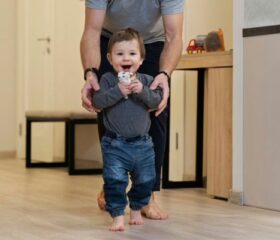Baby Month by Month
8-Month-Old Baby
You might hear your baby’s first word this month!

Alongside his eagerness to navigate his ever-expanding world, your baby will become much more independent this month. Let’s take a look at what milestones you can expect your little explorer to hit and how you can support his accelerating development.
Your baby’s physical development
Your baby is growing rapidly. On average, 8-month-old baby girls weigh around 17.5 pounds, while baby boys weigh around 19 pounds. As for height, girls are usually about 27 inches tall at this stage, while boys are almost 28 inches. 1 2
These are just averages, and many factors impact how big your baby is right now and how much he’s growing, like his: 3
- Genetics
- Health
- Diet
- Activity level
Premature babies often hit developmental milestones later
If your baby was born prematurely, you’ll need to use his adjusted age to determine how big he should be and when he’ll probably hit his developmental milestones (i.e., if he was born 8 weeks prematurely, his adjusted age at this point is actually 6 months).
Mobility on the rise
At 8 months, your baby should be able to move his neck around and flip over by himself. As your baby’s strength builds, so too will his eagerness to explore, so you might see him: 4
- Rolling around
- Sitting up on his own
- Scooting
- Moving from a seated position to crawling on all fours
- Pulling himself up to stand
- Moving along the edge of a surface (known as “cruising”)
- Bearing weight on his legs while holding onto something stationary
- Bouncing up and down while standing
Remember that babies don’t always develop at the same pace. Some may start earlier, and others later. It’s also normal for babies to even skip certain mobility milestones altogether (like crawling) and just start walking instead.
Regardless of where your baby is at, give him the chance to practice those adorable little moves.
Improved motor control
Your baby may continue to hone his pincer grasp this month (the fine motor skill that allows him to pinch his thumb and forefinger together).
Babies develop a crude form of this motor skill around 4 months old. However, they don’t usually fine-tune it until around the 12-month mark. 5
With your baby’s hands becoming more dexterous, he’ll interact more with the world around him. You might now see him moving objects from one hand to another. He’ll also be able to grip onto objects like small spoons for eating.
As this skill improves—as does his hand-eye coordination—your baby may try to put things in his mouth. You’ll have to be extra watchful during this time.
Your baby’s communication milestones
Your baby’s cognitive and language skills are advancing at a rapid pace, too. Most babies start babbling well before the 8-month mark, and past this point, your child’s “talking” will become more complex. He may already be able to form multi-syllabic utterances that resemble words, like “ma-ma” and “ba-ba.”
Perhaps your baby will even reach another exciting milestone soon: his first real word. Many babies say their first word when they’re around 6 months to 11 months old. 6
How will your baby communicate with you?
Your little one’s not yet at the age when babies start talking. Until he can truly talk your ear off with his first words, he will communicate with you in other ways.
For instance, your baby might gesture with his arms when he wants to be picked up. He’ll also become responsive to your words. If you ask him, “Where’s the doggy?” he might turn his neck to where your pet is. This is a good example of object permanence (knowing that things exist even when he can’t see them).
How to help your baby’s communication skills develop
As your baby’s verbal and communication skills improve, help him continue to build on them by:
- Speaking to him: The more you speak to your baby, the better his language skills will get. Keep talking until you wear out your voice—label objects, name everything, and ask him questions, too.
- Playing with him: Playtime is essential for babies’ cognitive and communicative skills. You can sing him songs, play games like peak-a-boo (which will also help reinforce object permanence), read books, or play with toys while chatting to him.
- Repeating everything: While it may make you go mildly insane, babies love repetition, so don’t be surprised if your baby wants to sing the same songs or read the same books with you over and over again.
- Highlighting your tone: Your baby is also sensitive to your inflection and can tell how you’re feeling by your tone of voice. 7 Take the time to describe the things you’re looking at or interacting with, and try emphasizing your tone so he can better understand the meaning behind the words you use.
Your baby’s emotional milestones
At 8 months old, your baby is more aware of his and other people’s emotions. 8 With that in mind, you can start teaching him how to regulate his fluctuating emotions by:
Providing encouragement and validation
Your baby is very attuned to your reactions. Cheer him on when he tries new things and encourage him to keep learning.
On the flip side, comfort and reassure him when he has setbacks. For instance, it’s common for 8-month-olds to develop a fear of strangers. He may become shy and cling to you. Make him feel safe while also demonstrating that he has nothing to fear.
Naming your feelings
Babies at this age frequently check in with their parents’ and caregivers’ reactions as they try new things, which helps them gauge their progress.
Verbalize how you feel and give a name to your emotions and reactions. Do the same for his emotional states so that he grows to understand how he’s feeling and knows he’s safe.
Balancing comfort and space
The 8-month mark is around the time when some babies develop separation anxiety. This ties into your little one’s understanding of object permanence. Now that he recognizes that things (including you) can exist even if he can’t see them, he may get frustrated when you’re not in sight.
Signs of separation anxiety include:
- Crying
- Screaming
- Clinging to you
Many babies also experience separation anxiety at night, which may result in your child not sleeping well, even if they weren’t previously having trouble.
It’s common for separation anxiety to last into your baby’s preschool years, which may result in tantrums and sometimes even vomiting. 9
Whether or not your baby begins to show signs of separation anxiety at 8 months, start experimenting with giving him space. Initiate short periods of separation to teach him that he’ll be OK when you’re out of sight.
Embracing your baby’s sensitivity
At 8 months old, your baby is stuck between two worlds. While he wants to explore his independence, he still wants to look back and know you’re there.
For many 8-month-olds, it’s not just the parent or caregiver they’ll look to for comfort. Many babies develop an attachment to a special blanket, toy, or stuffed animal. This “lovey” provides comfort and security as your baby transitions to more independence.
These transitional objects are a normal part of their emotional development. A lovey provides comfort as they learn to self-soothe.
Just be cautious about placing these objects in your baby’s crib. The American Academy of Pediatrics (AAP) recommends keeping loose blankets, soft items, or toys out of his crib. 10
Your baby’s teething milestones
Many babies start teething around this time, so your baby’s first teeth may have begun to come through. 11
You can tell that your baby is teething if he:
- Is drooling more often
- Has swollen gums
- Is irritable
- Is chewing on things more
Your baby may even refuse to eat if his teething pain is severe enough.
How to help your baby find relief during teething
To combat your baby’s teething discomfort, you can:
- Keep a small bib on him to dry his chin and prevent a rash
- Give him teething rings
- Massage his gums with your finger or a washcloth
- Chill the teething ring or washcloth (but never freeze them)
If he’s feeling very uncomfortable, it’s OK to give him over-the-counter pain medicines like ibuprofen or acetaminophen. 12 Just make sure to check with your pediatrician for the appropriate dose for his age.
When to speak to your doctor about teething
Although teething may be accompanied by a slight rise in your baby’s body temperature, fevers (over 100.4℉) are not common. If he has a fever or is experiencing extreme discomfort during this period, bring him to your pediatrician. 13
Your baby’s feeding milestones
As your baby gets more active, he’ll need to up his caloric intake to make up for the energy he’s burning in his home-turned-obstacle course. At 8 months old, your baby needs between 750 and 900 calories every day.
But while solid food is important to add to your baby’s diet, don’t cut out breast milk or formula yet. Breast milk or formula will still be his primary source of nutrition until he’s 12 months old, and he should get at least 400 to 500 calories from it per day. 14
Here are a few ways to curb your little one’s burgeoning appetite:
Expand the menu
At 8 months, it’s time to start experimenting. Start introducing coarser textures and new flavors to your baby’s diet. It may take a few tries to get him to accept new foods, so be patient during the process.
When introducing him to potentially allergenic foods (or any new food for that matter), take it slowly. Always start off with one new food at a time. 15
Moreover, certain foods are unsuitable for 8-month-olds (e.g., your baby can’t have honey until he’s a year old).
To get a better idea of which foods and drinks are safe and unsafe for your baby, check out the table below: 15
| Foods to introduce to your baby | Potentially allergenic foods (introduce them one at a time) | Foods to avoid giving your baby |
|---|---|---|
| - Infant cereals - Meat or other proteins - Fruits - Vegetables - Grains - Yogurts (made from pasteurized milk) - Cheese (made from pasteurized milk) |
- Dairy products (should be full fat, e.g., whole milk yogurt) - Eggs - Peanuts - Tree nuts - Shellfish - Fish - Wheat - Soy - Sesame |
- Cow’s milk beverages - Fortified soy beverages - Honey - Unpasteurized food and drinks - Raw foods (especially raw animal or seafood products, e.g., sushi) - Potential choking hazards (e.g., large pieces of raw vegetables or hot dogs) |
How to prevent your baby from choking
Remember that your baby is just beginning to eat solids, so he’s more at risk of choking. Plus, with very few (if any) teeth, he’s going to need some extra help making food small and soft enough to swallow and digest.
One thing you can do is choose safe finger foods. You can give your baby:
- Tiny pieces of meat
- Yogurt (as long as it’s pasteurized)
- Scrambled eggs (if you’ve already introduced eggs)
- Chopped or mashed fruit
- Small chunks of cheese
- Well-done pasta
- Pureed vegetables
Cut up anything larger than the size of a pea, and cook anything that’s too hard until it’s soft and mushy.
Tips for mealtimes
Your 8-month-old’s newfound independence doesn’t mean just physically exploring his environment. He’ll start pushing boundaries at mealtime, too.
No parent enjoys battling at the dinner table. If your baby is a fussy eater, here’s how you can make meals less disastrous:
- Stick to a schedule: As your child will start eating less frequently throughout the day, it’s important to stick to a schedule. Come up with 3 times when you will sit down and eat together every day.
- Be firm: Don’t give in if your baby refuses the healthy foods you prepare and then demands sweets and snacks later. Instead, reward him when he eats what you’ve made for him.
- Practice self-feeding: Something you can do to discourage mealtime battles and encourage mealtime success is to transition your fussy eater to self-feeding. Not only will this make mealtime feel more interactive and support his growing independent streak, but it’ll also help him improve his motor skills.
- Use cutlery: As his hand-eye coordination improves, you can give him a soft spoon to eat with. This is also around the time when you can introduce sippy cups filled with breast milk, formula, or small amounts of water. This will help wean him off the breast or bottle.
Once your child has the hang of his sippy cup, begin to transition him to an ordinary cup. The goal is for him to be exclusively using it by the one-year mark.
Your baby’s sleep milestones
At 8 months, you’ll likely find that your baby’s sleep patterns become more predictable. Also, if you’re continuing to wean your baby, you may find that middle-of-the-night feedings become less common.
Most 8-month-olds sleep between 12 and 16 hours every day. Your baby may start sleeping through the night for about 9 to 12 hours, with a few naps during the day. 16
Make a bedtime routine
Setting a consistent bedtime routine now will foster healthy sleep habits in your baby later on. Add soothing activities like warm baths and storytime to your baby’s routine, so he knows that it’s time to wind down.
How to deal with sleep regressions
Between teething, separation anxiety woes, and his growing independent streak, your baby might go through a sleep regression at this stage (when a baby that once slept well suddenly has trouble sleeping or resists it altogether). He may cry when you try to leave him, wake more frequently, or fight sleep altogether.
Sticking to an established bedtime schedule can help your little one through a sleep regression. Setting a routine throughout the day, factoring in his age-dependent wake windows, nap times, and mealtimes, can also make him more secure and know when it’s time to say night-night.
How to keep your 8-month-old healthy and safe
Your baby isn’t as little as he once was, but you’ll still need to keep him healthy and safe. All those physical developments mean he’s more likely to encounter hazards, and as he starts interacting with more people, he’s also more prone to picking up illnesses.
Tips for keeping your baby safe at home
Your 8-month-old is increasingly mobile, so you’ll need to keep a closer eye on him, especially during playtime and mealtimes. You’ll also need to:
- Babyproof: If you haven’t already, it’s time to get babyproofing! Secure any cabinets and cover outlets, and ensure potential hazards, poisonous substances, and small objects are out of reach.
- Keep his high chair safe: Make sure your baby’s high chair is the right size. Also, buckle him in whenever he’s seated in it.
- Keep his crib safe: Keep small, soft objects, blankets, and pillows out of the crib. Place it on its lowest setting to reduce the risk of falling if he stands up.
- Keep his car seat safe: Make sure your baby’s infant car seat is still appropriate for his age and weight. Always place it in the back seat so that it’s rear-facing.
- Modify your diaper changing setup: Consider adding a buckle to your diaper changing station if you don’t already have one. Another option is to change him closer to the ground or on the ground itself.
- Keep an eye on him outdoors: Since your baby is now more active, he’s more likely to hurt himself when you take him outside. For instance, while your baby can probably go on bucket swings once he learns to sit up independently, you should always supervise him and give him support if he needs it.
Your baby’s health at 8 months old
You probably don’t have a well-baby care checkup scheduled for 8 months. However, if you have any concerns regarding his health or development over the course of this month, don’t wait until the 9-month appointment.
Take your child to the pediatrician as soon as you start to suspect there’s a problem, whether it’s a serious issue affecting his sleep and appetite or a minor but troublesome issue like baby acne or cradle cap (flaky scalp). 17
Important shots at 8 months old
If your baby hasn’t had his respiratory syncytial virus (RSV) antibody shot yet, ask his pediatrician about scheduling it (all children are supposed to have it by the 8-month mark). 18
You should chat with your doctor about which other immunizations your baby needs. By 8 months, he should have received at least three doses of the following vaccines:
- Hepatitis B
- Rotavirus
- DTaP
- Hib
- Pneumococcal
- Polio
Talk to your pediatrician about whether it’s time for your baby’s COVID-19 or influenza shot, as these can be given as early as 6 months.
If you’re unsure of what your child has received to date, discuss it with your doctor. 19
Final thoughts
Welcome to the exciting world of 8 months old! As your baby starts getting more independent, get ready for a workout. You’ll probably spend much of the time chasing him around.
But with a strong-willed bundle of joy running around the house, brace yourself for the battles of bedtime and dinnertime. Though he might be more of a handful, take it as a sign that he’s developing well. If you ever need professional guidance, don’t be shy about calling your pediatrician.
And keep your camera in arm’s reach—you’ve got a lot of milestones to document!
Article Sources
- Medical News Today. "Baby weight chart by age" Retrieved July 17, 2025.
- Medical News Today. "Average baby sizes through the first year" Retrieved July 17, 2025.
- Mayo Clinic. "How much should I expect my baby to grow in the first year?" Retrieved July 17, 2025.
- Rady Children's Health. "7-9 Month Old Baby Development & Milestones" Retrieved July 17, 2025.
- NAPA. "Simple and Rewarding Pincer Grasp Activities for Babies" Retrieved July 17, 2025.
- Stanford Medicine Children’s Health. "Age-Appropriate Speech and Language Milestones" Retrieved July 17, 2025.
- Nemours KidsHealth. "Communication and Your 4- to 7-Month-Old" Retrieved July 17, 2025.
- First Things First. "Babies sense parents’ emotions to help understand their world" Retrieved July 17, 2025.
- American Academy of Child and Adolescent Psychiatry. "Anxiety and Children" Retrieved July 17, 2025.
- American Academy of Pediatrics. "Safe Sleep" Retrieved July 17, 2025.
- MedlinePlus. "Teething" Retrieved July 17, 2025.
- Children’s Hospital Los Angeles. "Tips for Teething Pain: What’s Safe—and What’s Not" Retrieved July 17, 2025.
- American Academy of Pediatrics. "Baby’s First Tooth: 7 Facts Parents Should Know" Retrieved July 17, 2025.
- American Academy of Pediatrics. "Sample Menu for a Baby 8 to 12 Months Old" Retrieved July 17, 2025.
- U.S. Centers for Disease Control and Prevention. "When, What, and How to Introduce Solid Foods" Retrieved July 17, 2025.
- Nemours KidsHealth. "Sleep and Your 8- to 12-Month-Old" Retrieved July 17, 2025.
- American Academy of Pediatrics. "AAP Schedule of Well-Child Care Visits" Retrieved July 17, 2025.
- Connecticut Children’s. "The New RSV Shot: 6 Must-Knows for Parents" Retrieved July 17, 2025.
- U.S. Centers for Disease Control and Prevention. "Your child needs vaccines as they grow!" Retrieved July 17, 2025.







